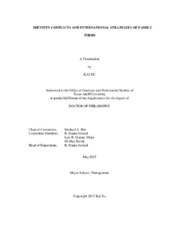| dc.description.abstract | In the current literature, there are seemingly incompatible predictions about the benefits and costs of internationalization for family firms. On the one hand, the behavioral agency model suggests that to preserve socio-emotional wealth, loss-averse family firms usually invest less internationally than nonfamily firms. In contrast, other scholars believe that international diversification has become a key way to protect family wealth. To reconcile the conflicting conclusions, I propose that whether family firms are able to achieve the economic benefits from internationalization as well as preserve their family identity is partly dependent on the how, when and where the family firms enter international markets.
From these theoretical underpinnings, a model is developed proposing that the mode of entry choice may mitigate the risk of loss of family identity. Specifically, family firms are more likely to choose Greenfield investment as their mode of entry to a foreign country. In addition, three formal institutional distances--economic, regulatory, and political—may create extra costs if family firms choose Greenfield investment as their entry mode.
I compiled the dataset of 2,595 family firms from 70 countries that invested in 38,014 subsidiaries from 89 countries between the years 2007-2013. The results show that family firms are more likely to use Greenfield investment as their entry mode when they try to protect their family identity and use M&A investment when they care more about their economic identity. The institutional distance significantly moderates these two main relationships.
Through this dissertation, I hope to make a number of contributions to the literatures of organizational identity, family firm, and institutional theory. First, in this study, I focus on the family firm internationalization strategy, and determine under what circumstances the two dominant identities (economic identity and family identity) of a family firm converge and under which they diverge when the reference points are changed. Second, this study contributes to the current institutional distance-mode of entry research by introducing additional dimensions of institutional distance. Third, I investigate the interactive effects between identities and institutional distance on mode of entry choice by introducing the institutional polycentricity concept in the theoretical framework. | en |


